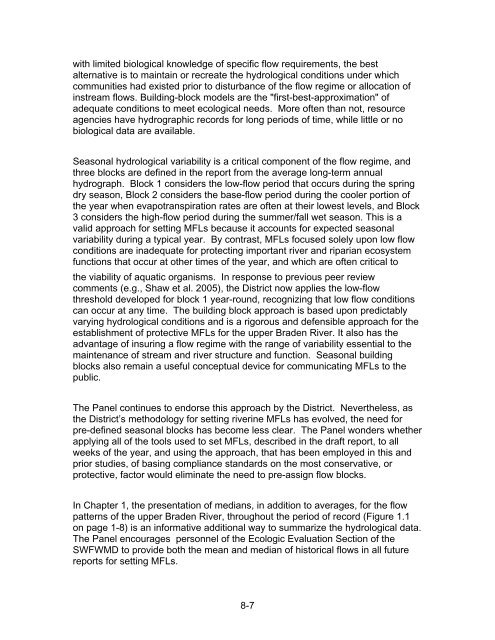Chapter 1 Minimum Flows and Levels - Southwest Florida Water ...
Chapter 1 Minimum Flows and Levels - Southwest Florida Water ...
Chapter 1 Minimum Flows and Levels - Southwest Florida Water ...
You also want an ePaper? Increase the reach of your titles
YUMPU automatically turns print PDFs into web optimized ePapers that Google loves.
with limited biological knowledge of specific flow requirements, the best<br />
alternative is to maintain or recreate the hydrological conditions under which<br />
communities had existed prior to disturbance of the flow regime or allocation of<br />
instream flows. Building-block models are the "first-best-approximation" of<br />
adequate conditions to meet ecological needs. More often than not, resource<br />
agencies have hydrographic records for long periods of time, while little or no<br />
biological data are available.<br />
Seasonal hydrological variability is a critical component of the flow regime, <strong>and</strong><br />
three blocks are defined in the report from the average long-term annual<br />
hydrograph. Block 1 considers the low-flow period that occurs during the spring<br />
dry season, Block 2 considers the base-flow period during the cooler portion of<br />
the year when evapotranspiration rates are often at their lowest levels, <strong>and</strong> Block<br />
3 considers the high-flow period during the summer/fall wet season. This is a<br />
valid approach for setting MFLs because it accounts for expected seasonal<br />
variability during a typical year. By contrast, MFLs focused solely upon low flow<br />
conditions are inadequate for protecting important river <strong>and</strong> riparian ecosystem<br />
functions that occur at other times of the year, <strong>and</strong> which are often critical to<br />
the viability of aquatic organisms. In response to previous peer review<br />
comments (e.g., Shaw et al. 2005), the District now applies the low-flow<br />
threshold developed for block 1 year-round, recognizing that low flow conditions<br />
can occur at any time. The building block approach is based upon predictably<br />
varying hydrological conditions <strong>and</strong> is a rigorous <strong>and</strong> defensible approach for the<br />
establishment of protective MFLs for the upper Braden River. It also has the<br />
advantage of insuring a flow regime with the range of variability essential to the<br />
maintenance of stream <strong>and</strong> river structure <strong>and</strong> function. Seasonal building<br />
blocks also remain a useful conceptual device for communicating MFLs to the<br />
public.<br />
The Panel continues to endorse this approach by the District. Nevertheless, as<br />
the District’s methodology for setting riverine MFLs has evolved, the need for<br />
pre-defined seasonal blocks has become less clear. The Panel wonders whether<br />
applying all of the tools used to set MFLs, described in the draft report, to all<br />
weeks of the year, <strong>and</strong> using the approach, that has been employed in this <strong>and</strong><br />
prior studies, of basing compliance st<strong>and</strong>ards on the most conservative, or<br />
protective, factor would eliminate the need to pre-assign flow blocks.<br />
In <strong>Chapter</strong> 1, the presentation of medians, in addition to averages, for the flow<br />
patterns of the upper Braden River, throughout the period of record (Figure 1.1<br />
on page 1-8) is an informative additional way to summarize the hydrological data.<br />
The Panel encourages personnel of the Ecologic Evaluation Section of the<br />
SWFWMD to provide both the mean <strong>and</strong> median of historical flows in all future<br />
reports for setting MFLs.<br />
8-7
















